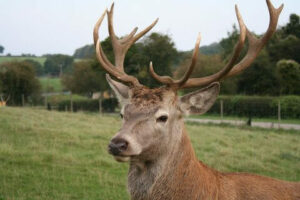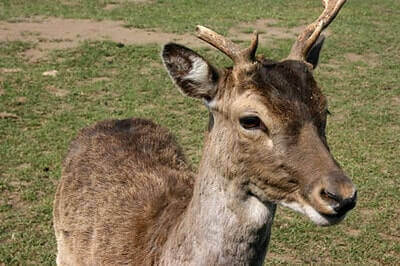Disclosure: We may earn commissions if you purchase products after clicking on a link from our site.
How to field dress a deer is an important skill to master as a hunter. It is very important to field dress your deer properly to save the meat from getting contaminated with bacteria. In this guide, we will walk you through the process of field dressing a deer step-by-step.
We’ll cover everything from how to make the initial cut to how to remove the guts. By following our tips, you’ll learn how to field dress a deer like a pro in no time!

Table of Contents
How To Field Dress A Deer
1. Set It Up For Incision
Setting up a deer for incision is a crucial step in the process of field dressing it. Before making any cuts, the hunter should position the deer on its back with its legs spread apart. This allows for better access to the abdomen and makes it easier to remove the internal organs.
It’s essential to choose a flat, stable surface to work on to prevent the deer from rolling or shifting during the process. Additionally, some hunters prefer to prop the deer’s hindquarters up on a log or other elevated surface to further stabilize it and facilitate the incision process.
Once the deer is properly positioned, the hunter can begin making the necessary cuts to remove the internal organs and prepare the deer for transport. Proper setup ensures efficiency and safety throughout the field dressing process.
2. Cut Around The Anus
Cutting around the anus of a deer is a necessary step in the process of field dressing it. After positioning the deer on its back with its legs spread apart, the hunter carefully locates the anus and surrounding area.
Using a sharp knife, the hunter makes a circular cut around the anus, taking care to avoid puncturing the intestines or bladder. This cut allows the hunter to detach the anus from the surrounding tissue and gain access to the pelvic canal.
By carefully cutting around the anus, the hunter can cleanly remove the rectum and lower intestine without contaminating the meat or compromising the integrity of the carcass. Proper technique at this stage ensures a thorough and efficient field dressing process, ultimately preserving the quality of the venison for consumption.
3. Start Cutting
Grab the skin by pinching it between the rear legs. Make a 1-inch incision into the skin. The hide and skin will pull away as you make short, shallow, and slicing cuts. Carefully make cuts to separate the skin from the meat. Use your fingers to help separate the hide from the organs. The knife should be facing upward and the cuts should be away from you.
4. Cut Up The Midline
Cutting up the midline of a deer is a crucial step in the process of field dressing it. After making the initial incision around the anus, the hunter proceeds to cut up the midline of the deer’s belly toward its chest.
Using a sharp knife, the hunter carefully slices through the skin and abdominal muscles, taking care to avoid puncturing the stomach or intestines. This midline cut allows the hunter to access the internal cavity of the deer and remove its organs.
By following the midline of the deer, the hunter can cleanly open the abdominal cavity and extract the internal organs, including the intestines, stomach, and other viscera. Proper technique during this step ensures efficient removal of internal organs and minimizes the risk of contaminating the meat with bodily fluids.
5. Sever the Diaphragm
Severing the diaphragm of a deer is a crucial step in the process of field dressing it. Once the midline cut has been made and the internal organs are exposed, the hunter locates the diaphragm—a thin, muscular membrane separating the chest cavity from the abdominal cavity.
Using a sharp knife, the hunter carefully cuts through the diaphragm to fully open the chest cavity. This allows for easier removal of the heart and lungs, which are typically left intact for inspection and potential consumption.
Severing the diaphragm also facilitates the removal of any remaining internal organs and ensures thorough field dressing of the deer. Properly completing this step is essential for maintaining the quality and safety of the harvested meat.

6. Cut the Windpipe
Cutting the windpipe of a deer is another essential step in the process of field dressing it. After making the necessary incisions to access the chest and abdominal cavities, the hunter locates the windpipe, which runs along the front of the throat.
Using a sharp knife, the hunter carefully cuts through the windpipe to disconnect it from the rest of the deer’s respiratory system. This allows for the proper removal of the deer’s esophagus and other internal organs connected to the throat area.
Cutting the windpipe ensures that the deer is fully field dressed, allowing for efficient and sanitary processing of the meat. Additionally, it helps prevent contamination and ensures the overall quality of the harvested animal.
7. Remove the Internal Organs
Removing the internal organs of a deer is a crucial step in the process of field dressing it. Once the incisions have been made and the windpipe severed, the hunter carefully reaches into the chest and abdominal cavities to remove the internal organs.
This includes organs such as the heart, lungs, liver, and intestines. By gently pulling them out, the hunter ensures that all the entrails are properly removed from the body cavity. Removing the internal organs not only facilitates the cooling of the carcass but also helps prevent contamination of the meat.
It is essential to handle the organs with care to avoid puncturing them, which could taint the meat with undesirable flavors or bacteria. Properly removing the internal organs is a key step in field dressing a deer and preserving the quality of the venison for consumption.
8. Drain the Blood
Draining the blood of a deer is an essential step in the process of field dressing it to ensure the meat remains fresh and flavorful. After removing the internal organs, the hunter can tilt the carcass to allow any remaining blood to drain out of the body cavity.
This can be done by elevating the hindquarters slightly higher than the front of the deer to encourage gravity to assist in draining the blood. Draining the blood helps reduce the gamy flavor sometimes associated with wild game meat and improves the overall quality of the venison.
It’s crucial to allow an adequate amount of time for the blood to drain completely before moving on to further processing or transporting the carcass. Properly draining the blood is an important step in field dressing a deer and contributes to the success of the hunting endeavor.

9. Let It Cool Down
Letting the deer meat cool down is a critical step in the process of field dressing it, ensuring the meat remains fresh and safe for consumption. After harvesting a deer, the hunter should allow the carcass to cool as quickly as possible to prevent bacterial growth and spoilage.
This can be achieved by hanging the deer in a cool, shaded area with good airflow, such as a meat locker or a well-ventilated garage. Cooling the meat promptly helps preserve its quality and flavor while also reducing the risk of foodborne illness.
Additionally, allowing the meat to cool helps relax the muscles, making it easier to handle during further processing. Properly cooling the deer meat is essential for maintaining its freshness and ensuring a delicious end product for the table.
How To Skin A Deer
1. Cut the skin around the neck.
2. Cut the inside of each leg to the middle of the carcass.
3. Pull the skin away from the meat at the head and pull down hard. It will come off down to the legs.
4. Cut off the skin from the meat down to the legs to remove the skin from the meat.
Tools For Field Dressing A Deer
1. A pair of gloves
A pair of gloves is an essential tool used during the field dressing process when harvesting a deer. These gloves protect the hunter’s hands from potential cuts, scratches, and exposure to bodily fluids while handling the carcass.
Additionally, gloves help maintain hygiene by preventing the transfer of bacteria and contaminants from the animal to the hunter. By wearing gloves, hunters can ensure that the meat remains clean and safe for consumption. Furthermore, gloves offer improved grip and dexterity, allowing for more precise and efficient field dressing.
Whether made of latex, nitrile, or other materials, a good pair of gloves is a fundamental component of any hunter’s field dressing kit, contributing to a safer and more sanitary processing experience.
2. A tarp or ground cloth
A tarp or ground cloth serves as a versatile tool when field dressing a deer, providing a clean and stable surface to work on while protecting the surrounding area from blood and bodily fluids.
Placing a tarp or ground cloth beneath the deer helps contain any mess and makes cleanup easier afterward. It also prevents the meat from coming into contact with dirt or debris, maintaining its quality and reducing the risk of contamination.
Additionally, a tarp can be used to transport the carcass or carry out other tasks during the field dressing process, adding to its practicality and convenience. Overall, having a tarp or ground cloth on hand is a valuable asset for hunters, ensuring a more organized, efficient, and hygienic field dressing experience.
3. Bungee cords or zip ties
Bungee cords or zip ties are indispensable tools when field dressing a deer, offering secure and flexible options for various tasks throughout the process. These items can be used to secure the deer’s legs and hooves, keeping them in place and preventing unwanted movement during dressing. They are also helpful for holding the deer’s chest cavity open, allowing easier access to internal organs for removal.
Additionally, bungee cords or zip ties can be utilized to fasten the hide or limbs out of the way, providing better visibility and maneuverability while working. Their adjustable nature enables hunters to tailor the tightness and positioning according to their needs, ensuring a smoother and more efficient field dressing experience. Overall, bungee cords or zip ties serve as versatile and practical tools that enhance the ease and effectiveness of deer processing in the field.
4. A sharp knife
A sharp knife is arguably the most essential tool when it comes to field dressing a deer. Its keen edge allows hunters to make precise cuts with minimal effort, facilitating the efficient removal of skin, organs, and other tissues.
Whether slicing through tough hide, separating joints, or carefully dissecting internal organs, a sharp knife ensures clean and effective work, reducing the risk of meat contamination and improving overall processing speed.
Additionally, a sharp knife minimizes the likelihood of accidental slips or injuries, providing greater control and precision throughout the field dressing process. Therefore, ensuring that one’s knife is properly sharpened and maintained is crucial for hunters looking to field dress deer effectively and efficiently in the field.
The Bottom Line
How to field dress a deer is not the sexiest part of hunting but is very important. It can be a little intimidating if it is your very first time doing it. In this article, we have given a step-by-step procedure to field dress a deer.
It is not difficult and you will only get better at it the more you do it. We did a review of the best field dressing kits on the market and you can read that from this link. You can also read how to hunt, how to hunt deer on public land, how to hunt deer at night, and how to plan a hunting trip out of state.
